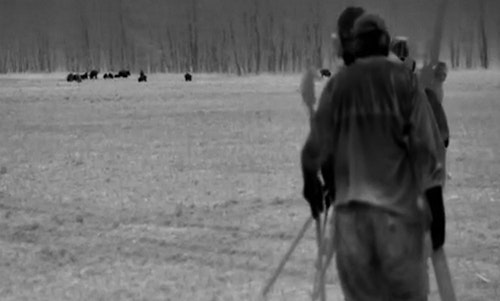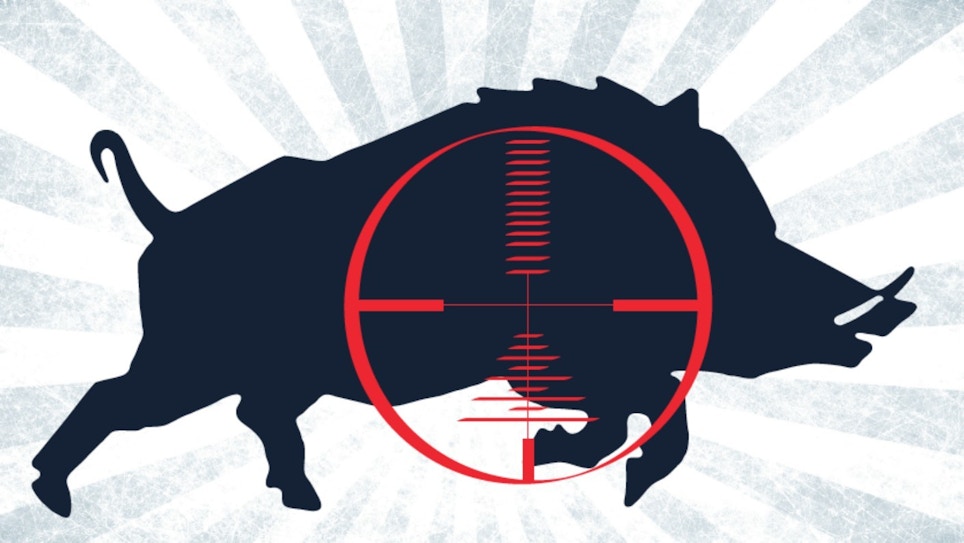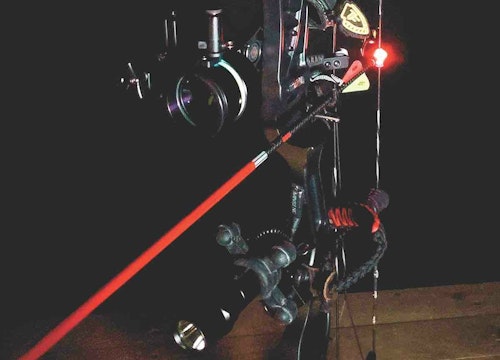One has to wonder if the godfather of our hog problem and famed Spanish explorer from our elementary school textbooks, Hernando de Soto, realized he had a piggy problem before he left the New World for an eternal one.
The fact that he brought 13 pigs to what we recognize today as Tampa, Florida, in 1539 and died in May 1542 with more than 700 live hogs on record should have stood as a warning. Unfortunately, at a time when surviving was a serious concern, any semblance of a warning was pushed aside to make room for more hogs brought over by explorers and colonists like Cortes and Sir Walter Raleigh, founder and leader of Jamestown Colony, settled in 1607.
In the centuries since, continued importation of hogs and unchecked population growth has led to our current-day problem. In my home state of Texas, the feral hog population has swelled to an estimate of 3 million or more. Worse, as the state with the highest number of feral hogs running rampant, we pay a hefty toll — more than $50 million in agricultural damage and more than $400 million in overall damage every year. Not only do hogs wreak havoc on agriculture, but they also compete with indigenous wildlife for habitat — and win.
With the ability to breed up to twice per year, litter sizes averaging six to eight with a 1:1 boar-to-sow ratio and, once large enough, no natural predators, hogs have left us with a serious problem. Experts suggest we need to kill nearly 70% of the total hog population every year just to keep numbers where they are — not to reduce numbers, but just to break even. Of course, we are not alone here in Texas. Hogs have been reported in at least 39 states and four Canadian provinces.
Hunting hogs has never been more important than right now. You can help your customers leverage their odds of success by offering effective hog hunting products. Check out this list of product categories sure to appeal to the hog hunters in your neck of the retailer woods.

Trail Cameras
One of the most valuable scouting tools available to hunters, trail cameras are our eyes (and sometimes our ears) when we’re not tromping around our favorite hunting spots. Most of today’s cameras produce high-resolution, full-color images during the daytime and black-and white-images, via infrared illumination, from dusk until dawn. Most current trail camera options also include 24-hour video capabilities, and some even include audio. Thanks to both day and night capabilities as well as time and date stamps, weather conditions, moon phases and other information, hunters can determine stand and blind placements and better forecast the activities of feral hogs and other wildlife.
More recently, trail camera technologies such as SpyPoint’s flagship offering, the Link-S, have pushed the high-tech envelope of HD wildlife imaging with a feature-rich combination of stealth IR illumination to eliminate any chance of detection, cellular connectivity for remote monitoring and an integrated solar panel.
Attractants
Again, like food plots where broadcaster feeders may not be legal, attractants like Texas Hog Bait can be quite effective. Where legal, attractants are often poured onto tree stumps or into PVC pipe pieces referred to as “pig pipes” and either partially buried or chained to a tree or wood post. Some attractants can also be used in broadcast feeders.
It’s important to let customers know if attractants you choose to carry are safe for feeders — some types gum up the gears and broadcasting element or cause corn or feed to clump, inhibiting material flow from the barrel to a feeder’s spinner plate. If you operate your business in a state that permits feeders, carry a hog attractant compatible with such systems so your hunters know they have dispersal options.
Firearms
While I am an avid bowhunter, when dealing with pesky, four-hooved crop thieves, I most often hunt with semi-automatic AR-15 and AR-10 modern sporting rifles topped with a Pulsar Trail XP30 Thermal Riflescope (more on optics later). There is no rhyme or reason related to which rifle I take hunting. I have a handful of favorites chambered in different calibers — most often AR-15s in 6.5 Grendel and 6.8 SPC II or AR-10s in .308 Win. or 6.5 Creedmoor. Since I may encounter multiple sounders of feral pigs in an expansive field and engage in multiple stalks, I generally use 20- or 30-round magazines.
As an outdoor writer, sometimes I do carry heavier rigs, but my preference is lighter rifle systems with sub-20-inch barrels (18-inch is a sweet spot for me, while others like 14.5- to 16-inch varieties). I try to keep my bare AR-15 rifle weight below 8 pounds and my AR-10 weight below 9 pounds. I also like to use a lightweight tripod-mounted gun rest. For customers with a penchant for bolt-action and lever-action rifles, I would keep your firearm suggestions pegged to more traditional, lightweight systems; however, picatinny optic and accessory rails can be helpful. I cannot say enough good things about Marlin Dark Series rifles and Mossberg’s 464 SPX.
Tripod-Mounted Gun Rests
Shooting sticks and monopods like BOG Pod can be helpful, especially if hunters have trouble getting into a comfortable sitting or kneeling position or if the terrain is too overgrown for prone shooting. I generally do not advise shooting from an unsupported off-hand (standing) position. That said, tripod-mounted gun rests like the Kopfjäger Reaper Grip have changed the hog-hunting game, including spot-and-stalk. Tripod-mounted gun rests like the Reaper Grip system allow for fluid pan and tilt adjustments throughout a shooting event and keep the shooter rock-solid, even when fatigued or shooting under duress after a physically demanding stalk and while dealing with adrenaline. I would suggest using a carbon-fiber tripod. My entire tripod-mounted gun rest weighs just 5 pounds or so.

Daytime Optics
More people are hog hunting with AR-platform modern sporting rifles than ever before; however, traditional bolt-action and lever-action rifles and crossbows are still favorites among hog hunters. Regardless of which firearm or crossbow your customers use, more often than not, the majority of their shots are likely to be close- to mid-range, from 25 to 200 yards and most often within 100 yards, especially in wooded areas.
For these reasons, true 1X-magnfication reflex or red-dot sights like Sightmark’s new Volta, as well as tactical-style 1-6X, 1-8X and 1-10X riflescopes are quite popular. More traditional hunting scopes with robust magnification adjustability, especially on the low end (a base magnification of 2X-3X), with top end magnification powers of 7X, 9X or even 12X are common. Recently, hog hunters also have turned to digital optics with full-color imaging in the daytime and digital night-vision imaging after sunset. Digital riflescope solutions are great for 24-hour hunting applications without the need to change firearms or optics.
Thermal and Night-Vision Optics
Where legal, thermal and night-vision optics have taken the hog hunting world by storm. An important distinction between the two is simply that thermal imaging is not night vision. Sure, both optic types allow imaging in the dark; however, thermal works equally well during daylight hours since the technology is based solely on temperature variances. It’s also worth mentioning that while night vision works by pulling in existing light particles (including from infrared illumination cast from the device) and converting them into exponentially more light particles to create an image, thermal imaging does not. Thermal employs an array of sensors that detect infrared radiation (heat) and processes the varying temperatures’ information into the display on the screen.
While thermal and night vision are cool, these technologies also are far from free. The good news here, however, is these optics also have never been more affordable. Night vision used to cost as much as $10,000 but can now be had for as little as $500. Thermal used to cost as much as $30,000, and now devices with respectable longer-range imaging quality can be had for as little as about $1,900.
Perhaps even more impressive is the affordability for top-of-the-line thermals. Rather than tens of thousands of dollars for lesser, nearly featureless 384x288-sensor resolution just a handful of years ago, today a flagship 640x480-sensor resolution device like a Pulsar Trail 2 XP50 LRF can be had for a fraction of that cost. Even better, today’s digital night vision devices deliver nighttime detection ranges comparable to Gen 2 and Gen 3 night vision, from 150 yards to 600 yards, while thermal images detect adult-size heat signatures as far away as 1,000 to more than 2,000 yards away.

Mounted Illumination
Mounted illuminators are quite a boon for hard-core hog hunters. While quite a bit less expensive than already affordable night-vision and thermal optics, these mounted light systems can illuminate your customers’ fields of view hundreds of yards out, often without spooking animals. As an avid rifle hunter and bowhunter, years before diving into thermal and night-vision optics, I had killed countless feral hogs with these types of high-intensity colored LED illuminators, as well as laser illuminators. My best takeaway was simply to avoid bright white light, but I have always had great success with red and green illumination.
A great example of quality mounted illumination can be found with Wicked Hunting Lights, a seven-time winner of Predator Xtreme’s Reader’s Choice Award (Predator Xtreme is a sister publication of Hunting Retailer). Color LED lights like Wicked’s lineup are not weakened by filters, making them more than capable of illuminating for ethical nighttime shots up to 300 to 400 yards away. Wicked Lights also offers color LED illuminators for nighttime bowhunting (more on that in a bit), as well as IR illuminators designed to extend night-vision riflescope detection ranges.
Ammunition
Sure, hog hunters have stacked truckloads of feral hogs with .223 and 5.56 ammunition for years. While I would recommend continuing to offer those calibers to diehard AR hunters running those cartridges, I also suggest carrying other popular hog-hunting cartridges. Today’s most popular AR-10 cartridges are .308 Winchester and 6.5 Creedmoor. Innovators like Phoenix Weaponry also produce insanely hard-hitting ammo like rimless .45-70.
Popular AR-15 cartridges, beyond .223 and 5.56, include 6.5 Grendel, 6.8 SPC II, 7.62x39, .300 AAC (Blackout), Wilson Combat’s .300 HAM’R, .350 Winchester, .450 Bushmaster, .458 SOCOM and .50 Beowulf. Hunters have also seen great hog-hunting performance from .22 Nosler and .28 Nosler, and I expect solid hog-hunting performance from Hornady’s 6mm ARC.
For bolt-action and lever-action rifles, popular deer-hunting cartridges seem to reign supreme, but with special emphasis on .30-caliber solutions like .30-30 Win., .30-.06 Springfield, .308 Win., .300 Win. Mag. and .300 WSM; however, other cartridges like .243 Win., 6.5 Creedmoor and .270 Win. also are not going away anytime soon. For feral hogs, target ammo and ballistic tip cartridges are not ideal. Feral hogs are tough, with thick skin, and often, especially with respect to large boars, they are quite a bit thicker around the front shoulders — their thick cartilage shields and bones can be tough to get through. Sure, hunters want expansion, but we also need penetration. Bonded and soft-tipped bullets with controlled expansion are excellent choices.
Sidebar: Nighttime Bowhunting
Nighttime bowhunting has become incredibly popular, but it requires the right setup for optimized target acquisition in the dark. With the vast majority of my personal bowhunting experience occurring from dusk until dawn, here are my suggestions for your customers.
Employ a laser illuminator or high-intensity color LED light that installs in a bow’s stabilizer hole. If possible, use an illuminator with a remote pressure switch mounted on the face of the bow’s riser. Firefield offers a great laser illuminator, while Wicked Hunting Lights offers a solid LED lighting system. Ensure the bow sight features a sight-light designed to only illuminate pins. My current sight of choice is an HHA Tetra Max single-pin sight with a rheostat sight light and 2X lens. Equally important is a larger peep sight. If a peep sight is too small, the target may be washed out. I suggest a peep size of at least 3⁄16-inch. My current favorite peep sight is a 1⁄4-inch, hooded Specialty Archery Peep Sight with an inserted 3⁄16-inch no. 6 verifier lens.
Finally, use illuminated arrow nocks. My personal favorite nighttime nock is Nock Out, by Clean-Shot. For solid blood trails and quick kills, I have always recommended fixed-blade broadheads; however, I have become quite a fan of New Era’s Zeus hybrid, two-blade broadheads. For mechanical broadheads, I’ve learned to trust Xecutioner Broadheads’ Xpandable, NAP’s Killzone and most recently, Rage’s Hypodermic NC. In addition to my bow setup, I also carry a thermal monocular for quick nighttime recovery.








